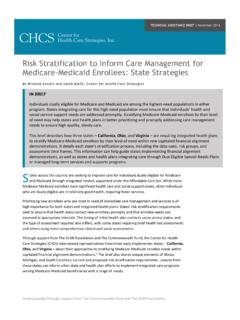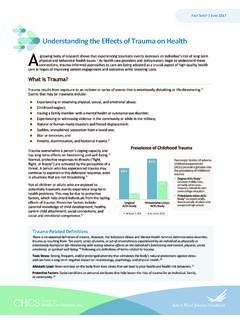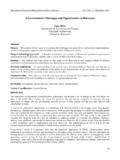Transcription of IDD Service Delivery Systems 082812 - Center for Health ...
1 CHCSC enter for Health Care Strategies, Inc. Trends and Challenges in Publicly-Financed Care for Individuals with Intellectual and Developmental Disabilities By: Gretchen Engquist, PhD Cyndy Johnson, and William Courtland Johnson, PhD Independent Consultants Made possible through support from: Schaller Anderson, an Aetna Company September 2012 Trends and Challenges in Publicly-Financed Care for Individuals with Intellectual and Developmental Disabilities 2012 Center for Health Care Strategies, Inc. G. Engquist, C. Johnson and Johnson. Trends and Challenges in Publicly-Financed Care for Individuals with Intellectual and Developmental Disabilities. Center for Health Care Strategies, Inc. September 2012. Systems of Care Innovations for Individuals with Intellectual and Developmental Disabilities Series This report is part of CHCS Innovations in Systems of Care for Individuals with Intellectual and Developmental Disabilities series, which was developed to help state and other policymakers identify and implement Systems of care that improve outcomes for individuals with intellectual and developmental disabilities, their families, and their communities.
2 The publications, supported by Schaller Anderson, an Aetna company, provide policy and technical resources to guide program identification and implementation. Other titles in this series available at include: Systems of Care for Individuals with Intellectual and Developmental Disabilities: A Survey of States Brief describes the results of a national survey of states regarding current Delivery Systems and planned innovations. Structuring New Service Delivery Models for Individuals with Intellectual and Developmental Disabilities Brief outlines guiding principles and core elements of person-centered Service Delivery models that focus on valued outcomes. About the Center for Health Care Strategies The Center for Health Care Strategies (CHCS) is a nonprofit Health policy resource Center dedicated to improving Health care access and quality for low-income Americans. CHCS works with state and federal agencies, Health plans, providers, and consumer groups to develop innovative programs that better serve people with complex and high-cost Health care needs.
3 For more information, visit Trends and Challenges in Publicly-Financed Care for Individuals with Intellectual and Developmental Disabilities 3 Contents I. Deinstitutionalization .. 4 Opposition to Further Deinstitutionalization .. 5 Fiscal Challenges in Transitioning from Institutional Care to HCBS .. 5 Residential Alternatives to Institutional Care .. 6 II. Community Support services for People with I/DD .. 6 III. Case Management .. 8 Rethinking Case Management .. 8 Rethinking Case Management in Hennepin County, Minnesota .. 9 Rethinking Case Management in New Jersey .. 9 Best Practices in Case Management for Persons with I/DD .. 10 IV. Direct Service Workers and Independent Providers .. 10 Independent Providers .. 10 Paid Family Caregivers .. 11 V. Resource Allocation .. 11 Prospective versus Retrospective Budgeting .. 12 Resource Allocation Tools .. 13 VI. Transitions from School to Adult Systems of Care .. 14 Transitioning to Adult services : There s More to Life Than TV.
4 14 Best Practices for Transitioning Students .. 14 VII. Meaningful Day Activities and Integrated Employment .. 16 Meaningful Day Activities .. 16 Integrated Employment .. 16 Employment First in Washington State .. 17 Person-Centered Career Planning .. 18 Person-Centered Care Planning: Making Dreams Real .. 18 VIII. Caring for Older Adults with I/DD .. 18 Aging Caregivers .. 19 Work-Related Issues .. 19 Physical Health Issues .. 20 Behavioral Health Issues .. 20 Best Practices in Caring for Older Individuals with I/DD .. 20 IX. Quality Oversight .. 21 Quality Performance Benchmarks .. 21 Trends and Challenges in Publicly-Financed Care for Individuals with Intellectual and Developmental Disabilities 4 here are roughly seven million individuals with intellectual and developmental disabilities (I/DD) in the United States, but only about 25 percent receive services through publicly-funded programs such as Medicaid and Medicare. The other 75 percent are supported by their families or live independently without publicly-funded supports and services .
5 That said, the number of publicly-funded beneficiaries with I/DD is growing at a rapid pace nationwide. There are various factors fueling this growth, including increased longevity, which heightens overall demand for services as aging caregivers lose the ability to care for loved ones. A second factor is a greater availability of non-institutional services and supports, which encourages families that would otherwise resist institutionalization to apply for In anticipation of an expanding population, this resource paper summarizes important trends and challenges facing the publicly-funded Service Delivery system for people with I/DD, including: The rebalancing of the I/DD system of care toward a greater reliance on home- and community-based services ; The community-based services and supports offered through most state waiver programs for persons with I/DD; The evolving role of the case manager; The evolving role of direct- Service workers and independent providers, including paid family members; Allocation of resources; Transition from school to adult Systems of care; Meaningful day activities and integrated employment; The challenge of caring for older adults with I/DD and their caregivers.
6 And Quality oversight and community integration. I. Deinstitutionalization Prior to World War I, psychiatric hospitals were almost the only out-of-home placement alternatives available to individuals diagnosed with I/DD. Following that era, the development of separate state facilities came into vogue and grew to such an extent that by 1967 the census of state institutions was almost 200,000 residents, with an facility average facility of more than 1,400. However, in the late 1960s a number of media expos s uncovering inadequate conditions, overcrowding, and a lack of treatment triggered increasing demand for reforms. In response, in 1971 the federal government established the Intermediate Care Facility for Persons with Mental Retardation (ICF/MR) program, enabling states to apply for federal matching funds under Medicaid to provide intermediate care in a federally-certified, publicly-owned institution. Predictably, most states embraced the program and the number of individuals residing in ICF/MRs increased dramatically during the 1970s.
7 In addition to improving the quality of care, ICF/MRs resulted in significant decreases in the number of residents served within individual facilities because many of the previous institutions had been overcrowded according to the new federal standards. In 1977, privately operated ICFs/MR also became eligible for federal reimbursement and by 1993 most persons receiving ICF/MR services were served in privately-operated institutions, and that trend continues today. Then in 1981 the federal government initiated home- and community-based services (HCBS) waiver authority, allowing states to implement non-institutional, community-based services for Medicaid-eligible beneficiaries meeting certain criteria. T Trends and Challenges in Publicly-Financed Care for Individuals with Intellectual and Developmental Disabilities 5 The passage of the Americans with Disabilities Act in 1990 and the Olmstead Supreme Court ruling in 1999 further encouraged the national trend toward deinstitutionalization.
8 In fact, from 1960 to 2008 the average daily census of large state-operated institutions for persons with I/DD declined by percent and the total number of facilities decreased from 354 to 168. In 1991, New Hampshire became the first state to close all of its public institutions, and since that time Vermont (1993), the District of Columbia (1994), Rhode Island (1994), New Mexico (1995), Alaska (1997), Hawaii (1999), Maine (1999), West Virginia (1999), and Michigan (2010) have followed New Hampshire s Two key factors have contributed to the policy shift away from institutions: first, there has been an expanding philosophical shift away from institutions and in support of community living; and second, the high costs of institutional care have made it more difficult for states to support institutional Opposition to Further Deinstitutionalization High costs aside, there remains vigorous resistance to further deinstitutionalization on the part of local communities, public employee unions, and a significant percentage of family members of facility residents.
9 Advocates for institutionalized care argue that there are some individuals, such as those with significant behavioral issues and/or complex physical and mental disabilities, who cannot be safely supported in the In addition, research has indicated that the ability to find, train, and keep direct-support staff remains one of the biggest barriers to continued deinstitutionalization and the ability to sustain current community supports. In most states, the wages of community support staff are consistently low, and institutional staff members have significantly better wages and benefits. Other barriers include a lack of trained medical and behavioral Health professionals to provide needed Service to persons with I/DD, the prohibitive costs of simultaneously operating ICF/MRs and community-based Service Systems during the transition period, and local community resistance to locating persons with I/DD in neighborhoods as well as concerns about land use and economic development.
10 And there are also beneficiaries who have lived in institutions for their entire lives and have now grown old, and moving them out of their familiar surroundings could prove painfully Despite these obstacles, many states have implemented successful strategies for supporting people with significant needs in the community, including those with psychiatric disabilities (so-called dually diagnosed individuals). In past years, states closed institutions by creating group settings in the community; today, the group home/community residence is increasingly viewed as an undesirable, unnecessary type of residential setting as compared to more typical homes designed and developed for individuals with ,7 But even the most ardent proponents of community residences acknowledge that not everyone can be effectively cared for outside of the group home setting. For example, individuals with severe autism often react inappropriately to the normal activities of home life, such as ringing doorbells, appliance noise, and dogs barking, etc.















